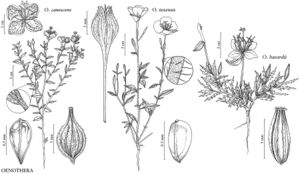Oenothera canescens
Rep. Exped. Rocky Mts., 315. 1845.
Herbs low, forming clumps 10–50 cm diam., densely strigillose throughout; from a taproot, lateral roots producing adventitious shoots. Stems many-branched from base, leafy, (10–)15–25(–38) cm. Leaves cauline, (0.3–)0.6–1.5(–2.5) × (0.05–)0.15–0.4(–0.6) cm, fascicles of small leaves 0.2–0.6 cm often present in non-flowering axils; petiole 0–0.1 cm; blade lanceolate to linear, base cuneate, apex acute. Flowers several opening per day near sunset; buds usually without free tips, rarely free tips 0.2–0.3 mm; sepals (7–)8–12 mm; petals pink, rarely white, streaked or flecked with red, fading bright purple, (8–)10–17 mm; filaments 6–8 mm, anthers often with red longitudinal stripe, 3–6 mm; style (16–)22–27 mm, stigma exserted beyond anthers at anthesis. Capsules woody, ovoid, narrowly winged, wings 0.8–1.5 mm wide, (7–)9–12(–14) × 2–4 mm (excluding wings), abruptly constricted to a conspicuous, sterile beak, (2–)3–4.5 mm, indehiscent; sessile. Seeds asymmetrically cuneiform or oblanceoloid, 1.2–1.5 × 0.4–0.5 mm. 2n = 14.
Phenology: Flowering May–Aug.
Habitat: Prairie depressions, playas, margins of ditches, temporary wet areas.
Elevation: (400–)700–1800 m.
Distribution
Colo., Kans., Nebr., N.Mex., Okla., Tex., Wyo.
Discussion
Oenothera canescens is restricted to prairie depressions, playas, ditch margins, and other places of temporary water in the High Plains of the western United States from Goshen County, Wyoming, southeast to Hayes County, Nebraska, south through eastern Colorado, the eastern tier of counties in New Mexico, western Kansas, and to Garza and Dawson counties in the Texas Panhandle; also disjunct populations from Chautauqua, Sedgwick, and Stafford counties, Kansas.
The illegitimate names Gaurella guttulata (Geyer ex Hooker) Small, G. canescens (Torrey & Frémont) Cockerell, and Gauropsis guttulata (Geyer ex Hooker) Cockerell pertain here.
Selected References
None.
